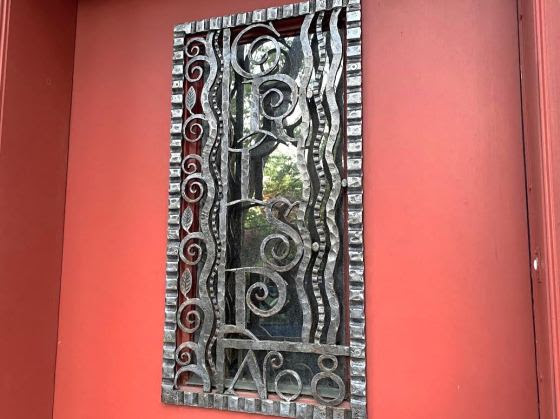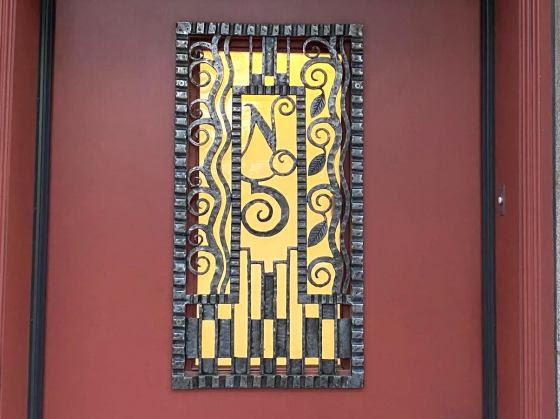Thursday, June 10, 2021 – TAKE A LOOK AT THIS WONDERFUL ENTRANCE


THURSDAY, JUNE 10, 2021
The
386th Edition
THE WONDERFUL
ENTRY TO
7 GRACIE SQUARE
FROM STREETSCAPES
CHRISTOPHER GRAY
NY TIMES (C)

On the typical apartment house, the front door is a cookie-cutter item, straight out of a catalog. But 7 Gracie Square, just off East End Avenue, is hardly typical, the project of a muralist who got into real estate.
The double doors and flanking ironwork are a frenzy of swirling shapes in brass and iron, plated with zinc, nickel and cadmium, populated by gazelles, elephants and sinuous plants. Now these 1929 masterworks of metal gleam in the north light from Carl Schurz Park, reinstalled earlier this month after a restoration.
The maisonette entrance to the left bears, in intricate script, the name Crisp, for this was the project of Arthur W. Crisp, a Canadian muralist who made good, very good, until the Depression hit. Born in 1881, Crisp came to New York around 1900, and studied at the Art Students League. By the 1910s he was getting mural commissions for theaters, institutions and private houses.
His private work was free and playful, but his public murals tended toward the conventional; in 1933 Lewis Mumford offhandedly described one as “sweet and dreadful.” Nevertheless, Crisp did well enough to buy real estate, including some old buildings on far East 84th Street. He bought in early 1928, just before the stubby dead end was renamed Gracie Square.

Crisp retained George B. Post & Sons, along with Rosario Candela, and they designed a tepid Art Deco facade of red brick, with vertical runs of brick set at an angle.
Magnificent metalwork doors, recently restored, distinguish 7 Gracie Square on far East 84th Street.Credit…Marilynn K. Yee/The New York Times

Renting began in the spring of 1929, when four- to seven-room apartments cost from $160 to $290 per month. The building had a gym and extra maids’ rooms. Some idea of the residents may be gained from a 1930 account in The New York Times: a tenant, Fanny Parsons, said that a handbag with $45,000 in jewelry had been stolen from her apartment. It turned out that she had left it in a taxicab. Whoops!
Mrs. Parsons and her $45,000 bag of jewelry went in and out through two brass-framed doors decorated with tendrils of nickel-plated bronze sprouting from howdahs borne by bronze elephants and coiling to fill the space.
Above the doors, a bowed-out tympanum of cadium-coated cast iron showcases two gazelles surrounded by a panoply of spiraling plants, all in a deep, rich silver.
Just inside the main doors, the radiator grilles are square-rigged ships of hammered iron plated with nickel.
Do not fail to notice the cunning little grilles on the doors of the flanking maisonettes. The one to the left with “Crisp” intricately worked into the metalwork was apparently the artist’s apartment, and directories list him here at the sub-number, 8 Gracie Square. The 1930 census records Crisp as paying $833 per month, far more than anyone else there, which is hard to explain. One tradition in the building has it that he occupied the penthouse, complete with organ loft.
A final touch is on the inner doors: The brass kick plate is cut in the shape of a rolling form called a Vitruvian wave, the whole package a perfect demonstration of the metalworker’s art. And what metalworker was that, exactly?

The apartment building at 7 Gracie Square, designed by George B. Post & Sons, was a project of Arthur W. Crisp, a Canadian muralist.Credit…Museum of the City of New York
Crisp is not known to have designed in metal, and the doors call to mind the work of the French designer Edgar Brandt, who had a few other commissions in New York, like the magnificent doors of the Cheney Brothers’ showroom at Madison and 34th.
The 1920s were good times in real estate. Crisp was on a roll, and in early 1929 engaged the Post firm for two more 15-story apartment houses, although these were not built. In May, five months before the stock-market crash, he bought 238 acres upstate. But the 1930s were not so swell, both for real estate and for business in general; in 1934 he appeared on a panel promoting the increased use of artwork in architecture.
And then, in 1935, the bank took back 7 Gracie Square, metalwork and all, at a foreclosure auction, paying $625,000 against the loan balance of $733,000. Crisp and his wife, Grace, also an artist, moved to Charlton Street.

In 1945 the tenants bought 7 Gracie for $500,000. The facade was rebuilt in 1993. The doors did not become a problem until recently, when the plating began to rub off, allowing the iron underneath to rust. In 2010 the co-op board retained Conservation Solutions of Washington to inspect and analyze the doors. Mark Rabinowitz, the company’s vice president, thinks it is likely the metalwork is by Brandt.
Suzanne Charity lives in Crisp’s old maisonette apartment, and has served on the board. She was active in an earlier renovation campaign, and says the building hired craftsmen in France to make gates, radiator covers and other details for the lobby that had always been lacking. The new fixtures are indistinguishable from the originals.
It is easy to pass by short little Gracie Square, until you know of the striking doors.
THE FDR PARK IS NOW FULLY
ACCESSIBLE TO ALL WITH NEW LIFT AND
UNDER TREE PAVING

EVER SINCE THE PARK OPENED IN 2012 (AND FOR MANY YEARS BEFORE) ISLANDERS COMPLAINED THAT THE PARK WAS NOT PLANNED TO BE FULLY ACCESSIBLE TO PERSONS WITH LIMITED MOBILITY.
A NEW STAIR LIFT HAS JUST BEEN INSTALLED ALONG WITH NEW PAVING UNDER THE LINDEN TREES.
WE HOPE THAT THIS WILL ENCOURAGE ALL TO VISIT AND FULLY ENJOY THE PARK.
JUDY BERDY

THURSDAY PHOTO OF THE DAY
SEND YOUR ANWER TO ROOSEVELTISLANDHISTORY@GMAIL.COM

WEDNESDAY PHOTO OF THE DAY
L’ETOILE AROUND THE ARC D’ TRIOMPHE
PARIS
ED LITCHER GOT IT.

Text by Judith Berdy
Thanks to Bobbie Slonevsky for her dedication to Blackwell’s Almanac and the RIHS
Thanks to Deborah Dorff for maintaining our website
Edited by Melanie Colter and Deborah Dorff
All image are copyrighted (c)
Sources
STREETSCAPES
CHRISTOPHER GRAY
NEW YORK TIMES (C)
FUNDING PROVIDED BY ROOSEVELT ISLAND OPERATING CORPORATION PUBLIC PURPOSE GRANTS CITY COUNCIL REPRESENTATIVE BEN KALLOS DISCRETIONARY FUNDING THRU DYCD


Copyright © 2021 Roosevelt Island Historical Society, All rights reserved.Our mailing address is:
rooseveltislandhistory@gmail.com



Leave a comment